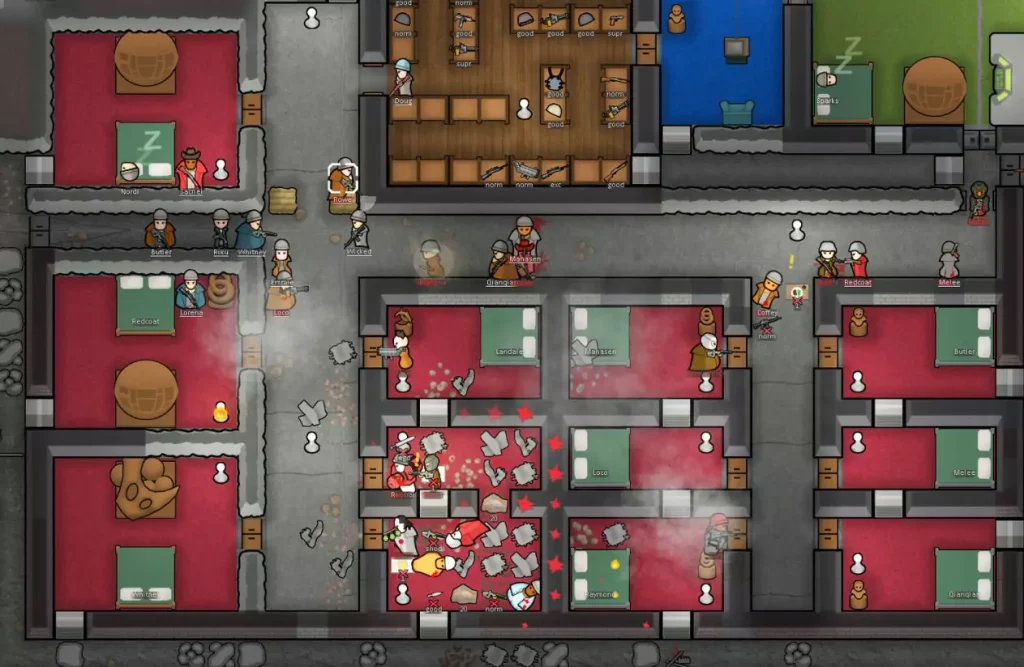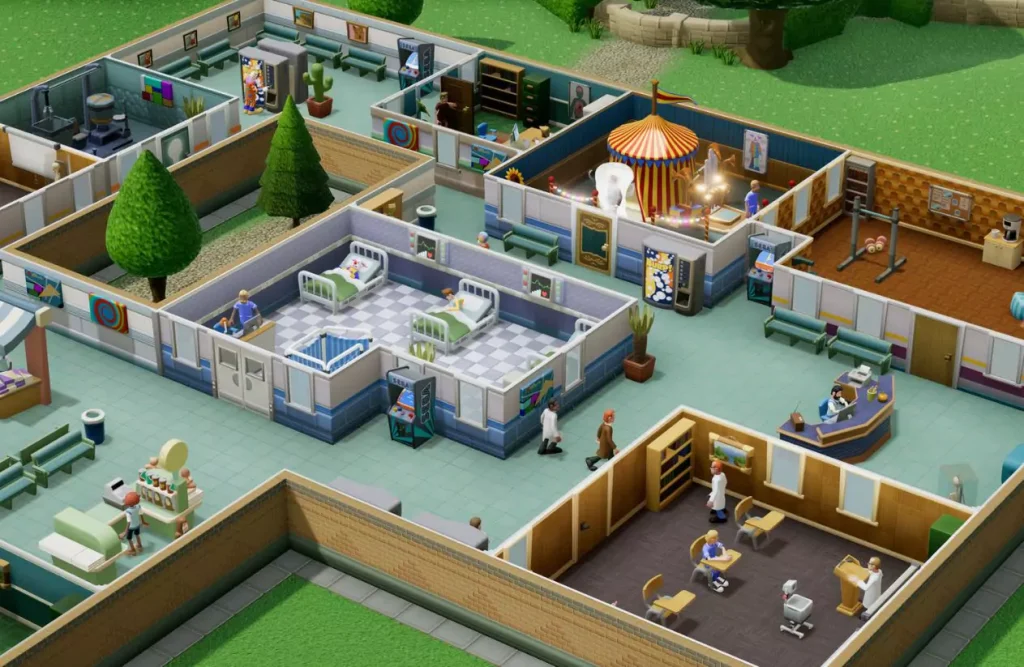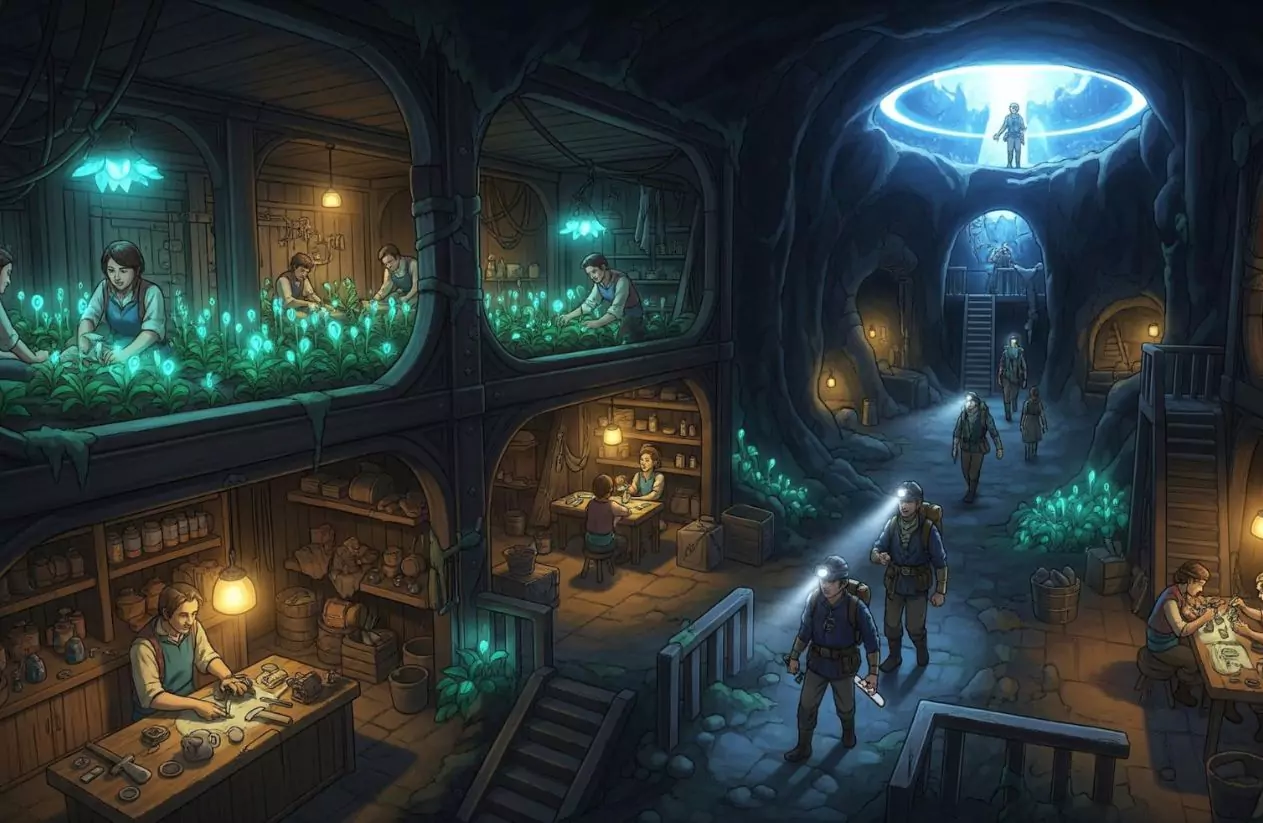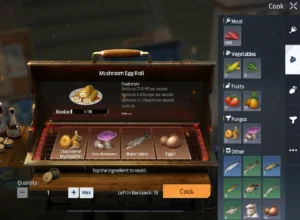Games Like Fallout Shelter: Discover Your Next Post-Apocalyptic Management Obsession
Ever found yourself lost in the captivating routine of resource management, dweller happiness, and the occasional Radroach infestation? If Fallout Shelter has truly captured your gaming heart, you’re not alone. There’s a unique charm to building a thriving underground community amidst a nuclear wasteland, a blend of strategy, simulation, and just a touch of post-apocalyptic humor.
But what happens when your vault is meticulously organized, your dwellers are all happy, and you’ve pretty much seen it all?
The craving for more, for that same blend of management and survival, starts to set in. Luckily, the gaming world is vast and full of hidden gems. Get ready to uncover some incredible titles that capture the spirit of your favorite vault-building adventure, offering fresh challenges and new worlds to explore.
If you’re searching for games like Fallout Shelter, you’re in the right place. Dive in to discover new worlds without ever leaving the comfort of your bunker (or couch).
Quick Look: More Management and Survival Games
If you’ve spent countless hours meticulously managing your vault dwellers and want a similar experience with a fresh twist, this list is for you. These games capture the strategic satisfaction of Fallout Shelter while challenging you with new scenarios, from a post-apocalyptic war zone to the icy grip of a new ice age.
- For a Deeply Emotional Experience: If you’re looking for a survival game that tests your morals, these titles are a must-play. This War of Mine puts you in the shoes of civilians trying to survive a brutal war, forcing you to make difficult, character-driven choices. Sheltered provides a more intimate take on the apocalypse, focusing on protecting a single family in a bunker with detailed management.
- For a Broader Strategy Challenge: These games expand the scope of management beyond a single bunker. Frostpunk challenges you to manage an entire city and make difficult ethical choices against a freezing apocalypse. Rebuild 3: Gangs of Deadsville is a turn-based strategy game that puts you in charge of reclaiming and rebuilding entire cities from zombie hordes.
- For Unpredictable, Unique Narratives: If you love a game where every playthrough tells a different story, these are for you. RimWorld is a sci-fi colony simulator that creates organic, emergent stories based on your colonists’ personalities and random events. Don’t Starve Together provides a cooperative survival experience where you must manage your health, hunger, and sanity in a quirky, procedurally generated world.
- For Action-Packed Management: If you want to blend your base-building with combat, these are excellent choices. State of Decay 2 is an open-world zombie game that combines community management with intense zombie combat. Judgment: Apocalypse Survival Simulation blends underground base building with tactical combat against a demonic threat, making every decision a matter of life or death.
This War of Mine

When I first stumbled upon This War of Mine, I expected a typical survival game, maybe something akin to managing resources in a post-apocalyptic setting. What I got instead was a gut-wrenching, deeply human experience that reshaped my understanding of the genre. It’s not about fighting zombies or building an impenetrable fortress; it’s about surviving as a civilian caught in a brutal war, day by day, decision by agonizing decision.
Why it Stands Out: This game doesn’t pull any punches. Unlike the often lighthearted tone of managing a vault, This War of Mine throws you into a grim reality where every choice has a heavy moral weight. I’ve had to decide whether to steal from an elderly couple to feed my starving group or risk someone dying of hunger. These aren’t easy calls, and the emotional toll is real. It’s a stark reminder that survival isn’t always about heroics; sometimes it’s about compromise and sacrifice.
Game Features that Hooked Me:
- Resource Scarcity and Management: Just like in Fallout Shelter, every scrap matters. I’m constantly scavenging for food, medicine, and building materials during the perilous night excursions. During the day, I’m back at the shelled-out house, deciding what to craft, who gets to eat, and who needs rest. It’s a constant juggle, and one wrong move can spiral into disaster.
- Character-Driven Narratives: Each survivor in my group has their own backstory, skills, and emotional vulnerabilities. I’ve watched them get depressed, injured, or even break down under the strain of war. Keeping their morale up is just as crucial as keeping them fed, adding a profound layer of human element to the management.
- Consequence-Heavy Choices: This is where the game truly shines. The narrative isn’t linear; it’s shaped by my actions. Helping a neighbor might deplete my supplies, but ignoring them could crush my group’s morale. The consequences of my decisions, both big and small, ripple through the game, making each playthrough feel incredibly personal and unique.
- Day-Night Cycle: The distinct phases of day (base management, crafting, healing) and night (scavenging, risky encounters) create a compelling rhythm. It’s a tense balance between preparation and perilous exploration, always pushing me to think ahead.
If you appreciate the resource management and character care aspects of Fallout Shelter but are ready for a much deeper, more somber, and incredibly impactful experience, then This War of Mine is an absolute must-play. It’s a game that stays with you long after you’ve stopped playing.
Sheltered

After the intense emotional journey of This War of Mine, I found myself drawn to Sheltered, another game that plunges you into a post-apocalyptic world, but with a slightly different focus: protecting a single family. This isn’t about managing a vast community; it’s about the intimate struggle of a small group trying to survive in a desolate landscape after a global catastrophe.
Why it Stands Out: What immediately grabbed me about Sheltered was the sheer weight of responsibility. I’m not just overseeing anonymous dwellers; I’m guiding a family – parents, children, and even a pet – through unimaginable hardship. Every decision feels incredibly personal because the well-being of these specific individuals rests entirely on my shoulders.
The game emphasizes the harsh realities of scarcity and the moral dilemmas that arise when resources are almost nonexistent. It’s a constant battle against hunger, thirst, radiation, and the psychological toll of isolation.
Game Features that Hooked Me:
- Family-Centric Survival: This is the core of the experience. I have to nurture each family member, managing their health, hunger, thirst, and sanity. Seeing them develop traits, get sick, or even succumb to the harsh environment makes every success feel earned and every failure sting.
- Bunker Management: My underground bunker is my sanctuary, and I spend a lot of time upgrading it, building new facilities, and ensuring it can protect my family from the outside world. It’s a satisfying loop of scavenging for materials and then using them to improve my living conditions.
- Expedition System: Sending family members out into the wasteland is always a tense affair. I have to weigh the risks of encountering dangerous wildlife or hostile survivors against the desperate need for supplies. The encounters are often text-based, forcing me to imagine the perils and make quick, crucial decisions.
- Crafting and Resource Scarcity: Just like any good survival game, crafting is essential. I’m constantly combining scavenged items to create tools, weapons, and essential survival gear. The scarcity of resources means I always have to prioritize, deciding what’s most vital for the family’s immediate survival.
Sheltered offers a more intimate, focused take on post-apocalyptic survival and resource management. If the idea of nurturing a small, vulnerable group through immense challenges resonates with you, and you appreciate the detailed base-building aspects, then this game will definitely pull you in.
State of Decay 2
Moving beyond the confines of a single bunker or house, State of Decay 2 throws players into an open-world zombie apocalypse where community building and resource management are key to long-term survival. This game shifts the perspective from a fixed shelter to establishing and maintaining a network of survivors in a dangerous, sprawling landscape.
Why it Stands Out: What makes State of Decay 2 compelling is its dynamic approach to community management. Instead of just building rooms, players are responsible for an entire enclave of survivors, each with unique skills, traits, and needs.
The world itself is a constant threat, not just from the undead but also from dwindling resources and the tough decisions that come with leadership. It’s a game that constantly pushes you to expand, consolidate, and protect your growing community against overwhelming odds.
Game Features that Engage Players:
- Community Management and Base Building: Players establish a base of operations and must manage their community’s morale, resources, and defenses. This involves constructing facilities like infirmaries, workshops, and farms, and assigning survivors to various tasks to keep the community thriving.
- Permadeath and Character Progression: Each survivor is a unique individual, and their skills can be developed through use. However, if a survivor dies, they are gone for good, adding a significant layer of tension and consequence to every scavenging run and combat encounter.
- Open-World Exploration and Resource Gathering: The game features large, explorable maps filled with abandoned buildings, resources, and hordes of zombies. Players must venture out to scavenge for supplies, rescue other survivors, and clear out infestations to make their territory safer.
- Strategic Combat and Zombie Threats: Combat is a mix of melee, ranged weapons, and stealth. Different types of zombies pose unique threats, requiring players to adapt their tactics. The “Blood Plague” infection adds an urgent medical crisis, forcing tough choices about treatment or isolation.
- Dynamic Events and Narrative: The world is alive with random events, survivor requests, and moral dilemmas that challenge players’ leadership skills and impact their community’s well-being. These emergent narratives make each playthrough feel distinct.
State of Decay 2 offers a more action-oriented and expansive take on post-apocalyptic survival, blending base management with open-world exploration and intense zombie combat. It’s a great fit for those who enjoy managing a group of survivors and making strategic decisions in a dangerous, evolving environment.
Frostpunk

Stepping into a world gripped by a new ice age, Frostpunk isn’t just about survival; it’s about leading the last remnants of humanity against an unforgiving, frozen apocalypse. This game elevates the city-building and resource management genre by intertwining it with profound moral dilemmas and a constant battle against the encroaching cold.
Why it Stands Out: Frostpunk distinguishes itself with its relentless pressure and the brutal choices it forces upon you. Unlike the relatively contained challenges of a vault, here you’re managing an entire city around a colossal generator, the last bastion of warmth. The game constantly tests your leadership, pushing you to make decisions that might save your city but cost you your humanity.
It’s a masterclass in atmosphere, where the biting cold is a palpable enemy, and every resource is a lifeline. If you’re looking for games like Fallout Shelter that truly test your strategic and ethical boundaries, Frostpunk delivers.
Game Features that Engage Players:
- Extreme Survival City-Building: Players must construct and manage a city around a heat-generating steam hub in a perpetually freezing world. This involves balancing resource collection (coal, wood, steel, food) with the needs of the population, including heat, housing, and healthcare.
- Moral and Ethical Choices: The core of Frostpunk lies in its “Book of Laws” system. Players must pass laws to maintain order and ensure survival, which often means making difficult, morally ambiguous decisions. Will you implement child labor to boost production, or will you allow radical faith to keep hope alive?
- Dynamic Weather and Temperature: The cold is a constant threat, with temperatures plummeting to deadly lows. Players must adapt their city layout and resource allocation to keep citizens warm, preventing sickness and discontent.
- Hope and Discontent Mechanics: Beyond physical needs, the city’s population has meters for “Hope” and “Discontent.” Managing these is crucial, as low hope can lead to abandonment, and high discontent can spark rebellion. Your choices directly impact these meters.
- Technological Progression: Researching new technologies is vital for survival, allowing for more efficient resource gathering, better heating, and advanced structures. This provides a clear sense of progression and adaptation.
Frostpunk offers an intense, atmospheric, and deeply challenging take on survival and management. It’s a game for those who relish complex strategic decisions and are prepared to grapple with the ethical weight of leadership in the face of utter devastation.
RimWorld

When I first encountered RimWorld, I was immediately captivated by its premise: leading a small group of survivors after a spaceship crash-lands on a distant, procedurally generated planet. It’s a sci-fi colony simulator that feels like a storytelling engine, constantly throwing unexpected events and challenges my way. Every playthrough unfolds into a unique saga, driven by the quirks of my colonists and the harsh realities of their new home.
Why it Stands Out: What truly sets RimWorld apart for me is its incredible depth in emergent storytelling. It’s not just about building a base; it’s about managing a group of individuals with their own personalities, relationships, skills, and even mental breaks. The game generates narratives organically, from dramatic raids by hostile factions to internal squabbles among my colonists, or even a sudden infestation of giant insects. It’s a constant balancing act of survival, expansion, and trying to keep everyone from losing their minds.
Game Features that Hooked Me:
- Complex Colonist Management: Each colonist is a fully fleshed-out character with traits, passions, and needs. I have to manage their moods, health, relationships, and assign them tasks based on their skills. Watching them develop, form bonds, or even fall in love adds a profound layer of personal investment.
- Procedural Storytelling: The “AI Storyteller” is a genius addition. It constantly introduces random events – good and bad – that shape the narrative of my colony. One day it might be a bounty of resources, the next a devastating plague or a siege by pirates. This keeps every game fresh and unpredictable.
- Base Building and Resource Management: Building a thriving colony from scratch is incredibly satisfying. I’m designing layouts, constructing rooms, setting up defenses, and managing a wide array of resources, from food and medicine to advanced components. It’s a meticulous process that rewards careful planning.
- Research and Technology Tree: Progressing through the research tree allows me to unlock new technologies, from basic farming to advanced prosthetics and even space travel. This provides a clear long-term goal and a sense of constant improvement.
- Combat and Defense: Raids are a regular occurrence, forcing me to design effective defenses and strategically deploy my colonists in combat. The permadeath aspect means every fight is high-stakes, and losing a valuable colonist can be devastating.
RimWorld is an incredibly deep and rewarding experience for anyone who loves colony management, emergent storytelling, and the challenge of guiding a group of individuals through extreme adversity. It’s a game that offers endless replayability and unique narratives with every new colony.
Oxygen Not Included
Venturing beyond the surface, Oxygen Not Included plunges players into the intricate world of asteroid colony management. This simulation game challenges players to excavate, build, and maintain a self-sustaining underground base for a group of quirky “Dupes” (duplicants) in a hostile, oxygen-deprived environment.
Why it Stands Out: Oxygen Not Included stands out due to its incredible depth in resource simulation and interconnected systems. It’s not just about getting enough food; it’s about managing gas pressures, temperature, liquid flow, and power grids, all of which interact in complex ways.
A seemingly small decision can have cascading effects throughout the entire colony. The game demands meticulous planning, problem-solving, and a keen understanding of thermodynamics and fluid dynamics (simplified, of course!). It’s a constant puzzle of optimizing systems to keep your Dupes alive and thriving in an alien world.
Game Features that Engage Players:
- Complex Resource Management and Automation: Players must dig through the asteroid, extract resources, and process them into usable materials. The game emphasizes automation, requiring players to design intricate systems of pipes, vents, and wires to move liquids, gases, and power efficiently.
- Environmental Simulation: The game features a highly detailed simulation of gases, liquids, and temperature. Hot biomes can boil water, cold biomes can freeze it, and different gases settle in layers. Understanding and manipulating these environmental factors is crucial for survival.
- Duplicant Needs and Personalities: Each Dupe has unique traits, skills, and needs, including oxygen, food, sleep, and morale. Players must assign tasks, manage stress levels, and ensure their living conditions are suitable to prevent mental breakdowns.
- Research and Technology Tree: A robust research tree allows players to unlock advanced technologies, from basic farming and sanitation to complex industrial machinery and space exploration. This provides long-term goals and a sense of progression as the colony grows.
- Base Building and Layout: Designing an efficient and sustainable base is paramount. Players must consider gas flow, heat dissipation, and logistics when placing rooms, pipes, and machinery. The vertical nature of the asteroid allows for creative and multi-layered base designs.
Oxygen Not Included offers a highly detailed and challenging colony simulation experience, perfect for players who enjoy intricate systems, resource optimization, and a constant stream of complex problems to solve. It’s a game that rewards patience, experimentation, and a good grasp of its underlying scientific principles.
Don’t Starve Together
Stepping into a darkly whimsical, yet brutally unforgiving wilderness, Don’t Starve Together takes the core survival mechanics of its single-player predecessor and amplifies them for a cooperative experience. This game challenges players to survive the relentless, bizarre dangers of the Constant, a mysterious world filled with unique creatures, changing seasons, and an ever-present threat of starvation and madness.
Why it Stands Out: Don’t Starve Together carves its own niche with its distinct gothic art style and its emphasis on cooperation (or competitive survival, depending on your group!). It’s not just about managing resources; it’s about understanding the intricate ecosystem of the Constant, learning creature behaviors, and mastering the cyclical nature of its seasons, each bringing new challenges.
The game’s charm lies in its hidden depths and the sheer variety of ways to perish, making every successful day feel like a hard-won victory. For those seeking games like Fallout Shelter that blend resource management with a unique art style and a strong survival focus, this title offers a compelling, often hilarious, and always challenging experience.
Game Features that Engage Players:
- Cooperative Survival: The “Together” in the title is key. Players must work collaboratively to gather resources, build a base, and fend off threats. This adds a dynamic social element, as coordination and shared goals are vital for long-term survival.
- Resource Gathering and Crafting: From chopping trees and mining rocks to hunting creatures and farming crops, resource management is at the core. An extensive crafting system allows players to create tools, weapons, structures, and magical items.
- Sanity, Hunger, and Health Mechanics: Beyond physical health, sanity is a crucial meter. As sanity drops, the world becomes more distorted, and shadowy creatures emerge. Balancing these three core needs is a constant challenge.
- Dynamic Seasons and Biomes: The Constant features distinct seasons, each with unique environmental hazards and resource availability. Players must adapt their strategies for summer’s heat, winter’s cold, and the dangers of spring and autumn. Various biomes offer different resources and creatures.
- Exploration and Discovery: The procedurally generated world encourages exploration. Discovering new biomes, rare resources, and unique creatures is essential for unlocking new crafting recipes and advancing your survival efforts.
- Unique Characters: Players choose from a roster of distinct characters, each with their own strengths, weaknesses, and unique abilities, adding replayability and strategic depth to team composition.
Don’t Starve Together offers a challenging, quirky, and highly engaging survival experience that thrives on cooperation and strategic resource management in a wonderfully strange world.
Project Highrise
Shifting gears from post-apocalyptic survival to the bustling world of urban development, Project Highrise invites players to become the ultimate architect and developer, tasked with building and managing a towering skyscraper. This simulation game is all about the intricate balancing act of creating a thriving vertical city, from its foundations to its soaring pinnacle.
Why it Stands Out: Project Highrise offers a unique blend of construction, economic management, and people simulation within the confines of a single building. It’s not just about stacking floors; it’s about understanding the complex interplay between different tenants – residents, offices, restaurants, and shops – and ensuring their needs are met to keep the entire ecosystem functioning.
The game challenges players to optimize space, manage utilities, and attract a diverse range of occupants, all while dealing with the demands of a growing, living structure.
Game Features that Engage Players:
- Vertical City Building: Players design and construct every aspect of their skyscraper, from the layout of individual apartments and offices to the placement of elevators, utilities, and service areas. The goal is to create a functional and aesthetically pleasing highrise.
- Tenant Management and Needs: Different types of tenants have varying demands. Residents need comfortable apartments and amenities, offices require efficient workspaces, and retail outlets need foot traffic. Players must provide services, manage noise, and ensure high satisfaction to keep tenants happy and paying rent.
- Resource and Utility Management: Keeping a skyscraper running smoothly requires careful management of electricity, water, telephone lines, and waste disposal. Players must plan utility networks efficiently to avoid outages and maintain services.
- Economic Simulation: The game features a robust economic system where players earn income from rent and services, and spend money on construction, maintenance, and upgrades. Strategic financial planning is essential for profitability and expansion.
- Service and Infrastructure Development: Beyond basic utilities, players must build and manage various services like restaurants, shops, security, and maintenance crews. These services contribute to tenant happiness and the overall prestige of the building.
- Prestige and Reputation: The success of a skyscraper is measured by its prestige. Higher prestige attracts more desirable tenants and allows for more ambitious construction projects. Players must continually strive to improve their building’s reputation.
Project Highrise provides a detailed and engaging simulation experience for those who enjoy intricate management, strategic planning, and the satisfaction of watching a complex system grow and thrive. It’s a perfect fit for players who appreciate the building and optimization aspects of simulation games, but with a unique vertical twist.
Graveyard Keeper
Stepping into a hilariously dark and surprisingly deep management simulation, Graveyard Keeper puts players in the shoes of a medieval graveyard manager. This game is far from your typical cozy farm sim; it’s a sprawling, often morally ambiguous, journey to build a successful and profitable graveyard business, no matter what questionable means are necessary.
Why it Stands Out: Graveyard Keeper distinguishes itself with its unique blend of dark humor, intricate crafting, and extensive progression systems. Unlike games focused on survival against external threats, here the challenges come from managing a macabre enterprise, dealing with bureaucracy, and navigating a world that’s both charmingly pixelated and surprisingly grim.
Players are constantly making choices about how to handle bodies, whether to cut corners, and how to maximize profits, often leading to ethically dubious but undeniably entertaining outcomes.
Game Features that Engage Players:
- Graveyard Management and Expansion: The core loop involves receiving bodies, preparing them for burial (or other uses!), and managing the graveyard’s reputation. Players must dig graves, craft gravestones, and even perform autopsies to improve the quality of their “product.”
- Extensive Crafting and Research: The game features a massive crafting tree, requiring players to gather resources, unlock new technologies, and create a vast array of items, from simple tools to complex alchemy ingredients. This depth provides a rewarding sense of progression.
- Resource Gathering and Base Building: Players explore the surrounding areas to gather wood, stone, metals, and other materials. They then use these resources to build and upgrade various facilities within their graveyard and surrounding land, such as workshops, farms, and even a church.
- Quirky Characters and Questlines: The world is populated by a cast of eccentric characters, each with their own demands and questlines. Fulfilling these often involves convoluted tasks and moral compromises, but they are essential for unlocking new areas, technologies, and story progression.
- Moral Choices and Consequences: The game frequently presents players with choices that blur the lines of morality. Will you sell questionable meat to the village, or use body parts for research? These decisions impact your relationships with NPCs and unlock different paths.
- Dungeon Exploration: Beyond the graveyard, there’s a dungeon to explore, offering combat, unique resources, and further mysteries to uncover, adding another layer of gameplay.
Graveyard Keeper offers a fresh, darkly comedic, and incredibly deep management simulation. It’s perfect for players who enjoy extensive crafting, resource management, and a game that doesn’t shy away from a bit of morbid humor and ethical ambiguity.
Two Point Hospital

Stepping into the quirky, often chaotic, world of healthcare management, Two Point Hospital invites players to design, build, and operate a series of increasingly bizarre hospitals. This vibrant simulation game is all about curing outlandish illnesses, managing staff, and keeping patients happy, all while turning a profit in a distinctly British comedic setting.
Why it Stands Out: Two Point Hospital shines with its charming humor, accessible yet deep management mechanics, and an endless parade of hilarious ailments. Unlike the grim realities of survival games, this title focuses on the lighter side of management, finding joy in diagnosing patients with “Light-Headedness” (a literal lightbulb for a head) or “Cubism” (patients with blocky bodies).
The game’s appeal lies in its ability to be both genuinely challenging and consistently entertaining, requiring strategic planning to optimize patient flow and staff morale, all wrapped in a delightful visual style.
Game Features that Engage Players:
- Hospital Design and Layout: Players are given an empty plot to build their hospital from the ground up. This involves designing efficient layouts for treatment rooms, diagnostic facilities, staff rooms, and patient amenities, crucial for smooth operations and patient satisfaction.
- Diagnosing and Curing Bizarre Illnesses: The game features a wide array of comical, fictional illnesses, each requiring specific diagnostic rooms and treatment machines. Players must train staff, upgrade equipment, and manage queues to cure patients effectively.
- Staff Management: Hiring, training, and managing a diverse team of doctors, nurses, assistants, and janitors is vital. Staff have their own personalities, skills, and needs, and keeping them happy and productive is key to the hospital’s success.
- Patient Happiness and Reputation: Patients have needs for food, drink, entertainment, and comfort. Meeting these needs improves their happiness, which in turn boosts the hospital’s reputation and attracts more patients.
- Research and Upgrades: Investing in research unlocks new diagnostic tools, treatment machines, and room types, allowing players to tackle more complex illnesses and improve their hospital’s efficiency.
- Economic Management: Balancing the books is essential. Players must manage income from patient fees against expenses for staff salaries, building costs, and equipment maintenance to ensure the hospital remains profitable.
Two Point Hospital offers a lighthearted, engaging, and surprisingly deep management simulation. It’s perfect for players who enjoy strategic building, resource allocation, and a good laugh, all within a vibrant and charming healthcare setting.
Game Spotlight: Judgment: Apocalypse Survival Simulation
Diving into a unique blend of base building, tactical combat, and colony management, Judgment: Apocalypse Survival Simulation places players in charge of a small group of survivors trying to establish a hidden base and rebuild civilization after a demonic apocalypse. This game isn’t just about surviving; it’s about fighting back against the infernal forces that have overrun the world.
Why it Stands Out: Judgment distinguishes itself with its compelling mix of base construction and real-time tactical combat. While players are busy fortifying their underground shelters and managing resources, they also have to lead their survivors on dangerous expeditions into a demon-infested world.
The game’s unique blend of genres means you’re constantly switching between the meticulous planning of your base and the adrenaline-fueled skirmishes against supernatural foes. It offers a fresh perspective on the post-apocalyptic genre, where the threat isn’t just scarcity, but an active, malevolent force.
Game Features that Engage Players:
- Underground Base Building: Players design and excavate an underground sanctuary, constructing rooms, workshops, and defenses. This involves managing resources, power, and the layout to create an efficient and secure haven for their survivors.
- Colony Management: Beyond just building, players must manage their survivors’ needs, skills, and morale. Assigning tasks, training new abilities, and keeping everyone sane are crucial for the colony’s long-term success.
- Tactical Real-Time Combat: When survivors venture out or are attacked, the game shifts to a tactical combat mode. Players control their team in real-time, utilizing cover, special abilities, and different weapon types to defeat demonic enemies.
- Research and Technology Tree: A comprehensive research tree allows players to unlock new technologies, from advanced weaponry and armor to more efficient resource production and mystical rituals to combat the demonic threat.
- Exploration and Scavenging: Expeditions into the ruined world are essential for gathering resources, rescuing other survivors, and discovering new locations. These outings are fraught with danger and require careful planning.
- Demonic Threat and Progression: The game features a persistent demonic threat that evolves as the game progresses. New enemy types and more challenging encounters keep players on their toes, forcing them to constantly adapt their strategies and defenses.
Judgment: Apocalypse Survival Simulation offers an engaging and unique take on the survival and management genre, combining the satisfaction of base building with the thrill of tactical combat against a supernatural enemy. It’s a great choice for players who enjoy both strategic planning and active engagement with threats.
Rebuild 3: Gangs of Deadsville
Stepping into a world overrun by zombies, Rebuild 3: Gangs of Deadsville offers a compelling turn-based strategy game focused on reclaiming and rebuilding cities from the undead hordes. This isn’t just about surviving; it’s about leading a diverse group of survivors, managing resources, and making tough decisions to restore civilization, one block at a time.
Why it Stands Out: Rebuild 3 distinguishes itself with its unique blend of city management, strategic combat, and emergent storytelling. Players aren’t just building a base; they’re expanding their influence across an entire city map, sector by sector.
The game’s strength lies in its procedural generation and the constant stream of events, from internal survivor conflicts to external gang rivalries, that make each playthrough feel fresh and unpredictable. It’s a game that rewards careful planning, strategic expansion, and the ability to adapt to a constantly changing, zombie-infested landscape.
Game Features that Engage Players:
- City Reclamation and Management: The core gameplay involves sending survivors to clear out zombie-infested areas, reclaim buildings, and convert them into homes, farms, workshops, or defensive structures. Players must manage resources like food, materials, and morale to keep their growing settlement thriving.
- Survivor Management and Specialization: Each survivor has unique skills and traits, and players must assign them to various tasks like scavenging, building, farming, or defending. Developing their skills and keeping them happy is crucial for efficiency and preventing desertion.
- Turn-Based Strategy and Combat: The game progresses in turns, allowing players to plan their actions carefully. When survivors encounter zombies or hostile factions, combat unfolds in a tactical, turn-based manner, requiring strategic positioning and ability usage.
- Diplomacy and Faction Relations: Players will encounter other survivor factions, each with their own agendas. Decisions about alliances, trade, or conflict will significantly impact the game’s progression and the safety of your settlement.
- Research and Technology Tree: A research tree allows players to unlock new technologies, improving their building capabilities, combat effectiveness, and overall survival chances. This provides a clear sense of advancement and strategic depth.
- Narrative Events and Choices: The game is rich with random events and narrative choices that force players to make difficult decisions, often with moral implications. These choices can affect survivor loyalty, faction relations, and the overall story arc of your playthrough.
Rebuild 3: Gangs of Deadsville offers a deep and engaging turn-based strategy experience, combining the satisfaction of city-building with the tension of zombie survival and complex faction dynamics. It’s an excellent choice for players who enjoy strategic planning, resource management, and a game that constantly presents new challenges and emergent stories.
Mr. Prepper
Stepping into the shoes of a suburban citizen preparing for an impending nuclear catastrophe, Mr. Prepper is a unique survival and crafting game that blends underground base building with stealth and resource management. This game isn’t about the apocalypse itself, but the meticulous, often paranoid, process of getting ready for it, all while avoiding the watchful eye of the government.
Why it Stands Out: Mr. Prepper offers a distinct twist on the survival genre by focusing on the pre-apocalypse phase. The tension comes not from external zombie hordes, but from the constant need to expand your underground bunker, gather resources, and craft essential survival items, all while maintaining a facade of normalcy for your suspicious neighbors and the ever-present government agent. It’s a game about secrets, resourcefulness, and the delicate balance between preparing for the worst and not drawing unwanted attention. If you’re looking for games like Fallout Shelter that emphasize underground construction and resource gathering in a unique, narrative-driven setting, Mr. Prepper delivers a fresh experience.
Game Features that Engage Players:
- Underground Bunker Construction: Players must excavate and build a multi-layered underground bunker beneath their seemingly ordinary suburban home. This involves designing rooms, installing utilities, and expanding their hidden base to store supplies and machinery.
- Resource Gathering and Crafting: A vast array of resources must be gathered from the surface world and processed into useful items. The game features an extensive crafting system for tools, food, weapons, and complex machinery needed for survival.
- Stealth and Deception: A key mechanic is avoiding suspicion. Players must manage their activities to not alert the government agent who periodically inspects their home. This involves hiding illegal items, maintaining a normal appearance, and discreetly disposing of waste.
- Survival Mechanics: Basic survival needs like hunger and thirst must be managed, along with the mental state of Mr. Prepper. The game also features a day-night cycle and seasonal changes that impact resource availability.
- Exploration and Trade: While mostly confined to his home, Mr. Prepper can interact with other characters in the town to trade for rare resources or information, adding a social and economic layer to the game.
- Story Progression and Escape: The ultimate goal is to build a rocket and escape the impending doom. This involves completing various objectives, researching new technologies, and making strategic choices to ensure a successful departure.
Mr. Prepper provides a compelling and often humorous simulation of pre-apocalyptic preparation, combining detailed base building and crafting with unique stealth and deception mechanics. It’s an excellent choice for players who enjoy meticulous planning and a distinct narrative hook in their survival games.
Also Check Our Article: Best Games Like Minecraft







